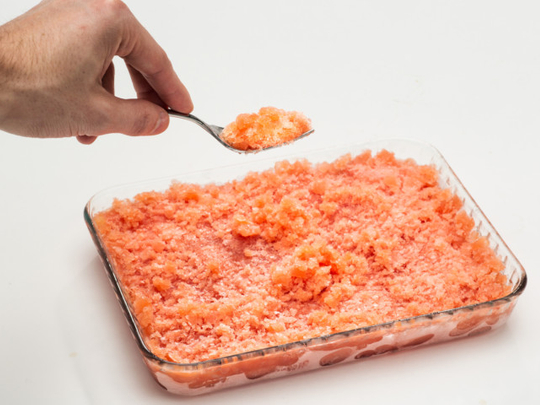
Granita (pronounced grah-NEE-tah) is the name for an Italian ice of rough, jagged crystals. It melts the minute it hits your tongue, sending a shiver of cold straight down the throat. The classic flavours are lemon and coffee, but granita comes in other flavours too, including one made with jasmine. The ultimate, though, has to be the almond granita made from an infusion of crushed almonds in water served with warm brioche for breakfast at Caffe Sicilia in Noto, Sicily.
In fact, the inspiration for Sicily’s slushy ice comes from the Arabs who once ruled the island. And over the centuries, granita has become a tradition over much of southern Italy. In 19th century Naples, colourful carts festooned with lemons used to dispense granita di limone at the height of summer.
The mystery is why granita rarely shows up on Italian menus in Los Angeles, edged out by gelato and sorbetto made in gelato machines that do all the work.
For the home cook, the beauty of granita is that it doesn’t require a fancy ice cream or gelato machine. All you need is a shallow metal or glass baking pan and a fork. Really.
And some spectacular fruit.
Since the ice involves no dairy, it’s a purist’s dessert, highlighting sweet, juicy tangerines or fragrant lemons.
In Provence, a cook friend once looked out the window of the house we were renting and spied a cherry tree loaded with fruit. Soon we were gleefully squeezing cherries with our hands to get the crimson juice. A couple of hours later, we were spooning jaggedy ice crystals of cherry granita into our mouths in the dark.
To make granita, start with three or four cups of freshly squeezed fruit juice — cherry, lemon (cut with water), tangerine, blood orange, grape, even pureed melon or peaches. You can, of course, make it with juice you buy, but the result won’t taste as vibrant.
Add sugar (preferably fine baker’s sugar) or simple syrup to taste, just sweeter than you’d like to drink it. (After freezing, the granita will taste much less sweet.) How big the crystals get depends on how much sugar is in the mix. Less sugar, bigger ice crystals.
Pour the mixture into a shallow baking pan. Ideally, the liquid shouldn’t be much more than an inch deep or it will take a long time to form the ice crystals.
Place the pan in the freezer. After about an hour, check to see if ice has started to form on top and around the edges. If not, wait some more. Once you can see the ice, take that fork and scrape the ice crystals into the middle. Come back a half-hour later, scrape again. Repeat several times until all the liquid is frozen.
Just before serving, fluff up the granita with the fork and serve it heaped into footed ice cream bowls. (If the granita is too firm, let the container stand out at room temperature for a few minutes before serving.) Serve it with cookies or even a scoop of vanilla bean ice cream, the way chef Jennifer Naylor used to do at Wolfgang Puck’s Malibu restaurant, Granita.
TANGERINE (OR OTHER CITRUS) GRANITA
Time: 10 minutes, plus freezing time.
Serves four to six
Ingredients
2 1/2 cups tangerine and blood orange juice (or other citrus juice), pulp strained
2 to 4 tbs superfine sugar, or to taste
Steps
- Combine the juice and 2 tbs sugar, whisking until the sugar is dissolved. Taste and add additional sugar as desired; the mixture should be sweet (the sweetness will fade as the granita freezes).
- Pour into a shallow baking dish so the mixture comes up the sides approximately 1 inch.
- Freeze, checking occasionally to see when ice begins to form on the top and sides, after an hour or so, and begin scraping the ice crystals into the centre of the pan with a fork. Continue to freeze, scraping occasionally, until there is no more liquid in the pan.
- Just before serving, fluff the crystals with a fork. Serve heaped into ice cream bowls.
NOTE: If you are making a lemon granita, cut the lemon juice with water just as you would for lemonade.
— Los Angeles Times








